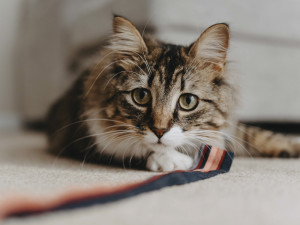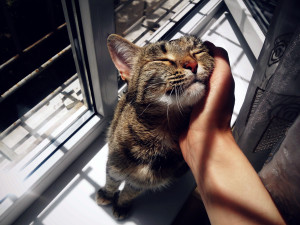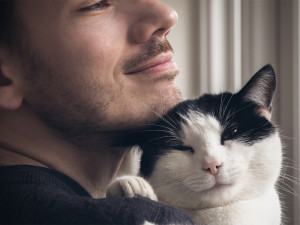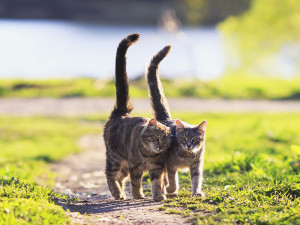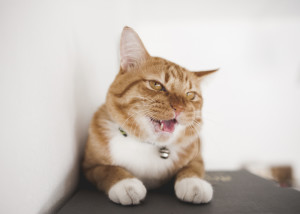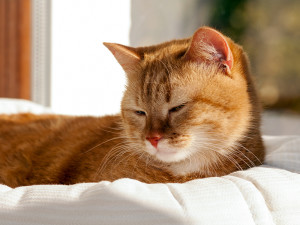Is My Cat Happy?
In this excerpt from her new book, Purr: The Science of Making Your Cat Happy, animal behaviorist Zazie Todd shares science-backed insights into our cats’ moods.
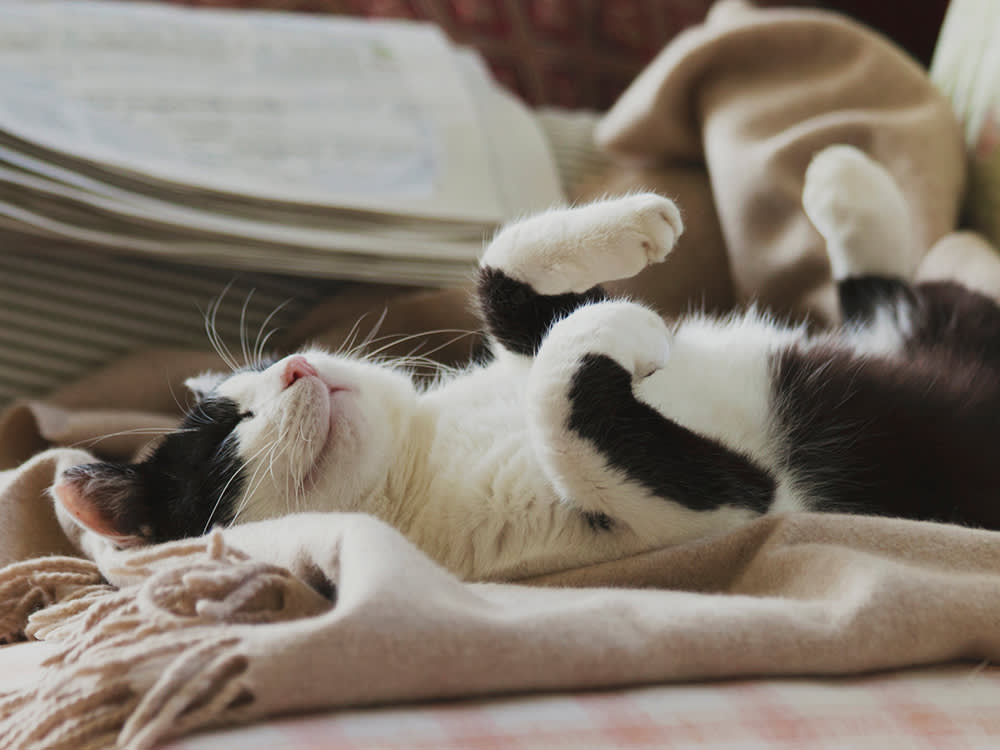
share article
When you look at your cat, you don’t know what’s happening inside their brain. But it is really helpful to have a good idea of how to recognize feline emotions from their behavior. For ease of explanation, let’s consider feline body language in two groups: signals aimed at decreasing distance (purr purropens in a new tab, come closer) and signals that mean the cat is trying to increase distance. Pay attention to all of your cat’s body parts when trying to understand their body language, and to the speed at which actions happen. For example, a slow-blink is a sign of a relaxed catopens in a new tab, whereas a rapid blink with scrunched-up eyes is a sign of fear.
Essentially, the more open your cat’s body position, the less stressed they are. A cat who is lying on their side or their back with their legs stretched out, their tail loose and out, and their belly on show is relaxed. Their eyes might be fully or partially closed, or doing a slow-blink at you if you’re lucky, and the ears and whiskers will be in a normal position. Signs that your cat wants you to stay away include a swishing tail, rippling skin, a flattened body (as if trying to be invisible), the limbs and tail tucked in close to the body, hissingopens in a new tab, spitting, and caterwauling.
If you see these signs, don’t approach your cat, because they may feel forced to defend themselves with tooth and/or claw. Instead, give them space. If you were petting them, stop — before they have to make it even more clear that enough is enough. It is always best to let a cat approach you and give them a choice of whether or not to interact with you.
Cats can become frustrated because they are bored, unable to access something they want (such as food or a bird they can see through a window), or unhappy at being in a shelter, where they may make a mess of their cage by tipping out their food and water bowls, knocking over their litter tray, and attempting to escape by putting their paws through the bars, pushing their body against the cage door, and biting the cage.
Signs of frustration include this kind of destruction and trying to escape, as well as meowing a lot, pacing up and down, and rubbing on things a lot. They will be highly aroused with a thrashing tail, and you may see their skin ripple too. Be very cautious with a cat in this state, as you may be at risk of a redirected bite — one where you aren’t the cause of the aggression, but you happen to be there so you get the result of it. You can help to prevent frustration by figuring out what the cat wants and finding ways to safely provide it to them.
Humans often look at facial expressions for clues about emotion, and yet the fact that there’s such wide variety in the shapes of cats’ faces makes it hard to learn to read their emotions this way. But scientists are making advances in this tricky area. In one study, they looked at the faces of cats in shelters both during petting (with a hand or a touch stick) and while just in the cage. Because of the different face shapes, the researchers looked at how the face changed from a normal position.
They were especially interested in what might be signs of FEAR, SEEKING, and RAGE. Being afraid was associated with a low, flat posture, with hidingopens in a new tab, and with retreating and moving back, often with a freeze (a moment of keeping still) beforehand. As well, they found that the direction of the cat’s head was associated with their emotions; a leftward gaze or turn of the head when the cat was fearful, and a gaze or turn to the right in a relaxed cat. Some of the cats in the study were frustrated, and signs included licking the nose, the tongue being visible, and hissing.
Scientists have also developed and validated a feline grimace scale that may be useful to veterinarians wondering if a cat is in pain or notopens in a new tab. The facial signs they identified are a change in the muzzle shape (oval and bulged rather than round); changes in the position of the tips of the ears (far apart and facing out); a narrowing of the eye area with the eyes potentially partly closed; and the whiskers being forward, straight, and away from the face, instead of the usual lovely, relaxed curve.
As well, the head was lower than usual, below the shoulders or with the chin tucked close to the chest. This scale is designed for professional use and these signs may not be easy to spot, but if you are ever concerned about your cat’s health, always see your veterinarian.
Cats’ reputation for being hard to read is part of their mystique. And we love them almost because of this, rather than despite it. If you find it hard to read your cat’s body language, you are not alone. Most people performed worse than chance when scientists showed them videos of cats and asked them to say if the felines were feeling positive or negative emotions (happy or unhappy, if you like). Only 13 percent of people were good at it, and they weren’t your average pet owner — rather, they were people who worked with cats, such as veterinarians, vet techs, and people who work in animal shelters.
Experience with many cats may play a role in discerning these emotional shifts, but it could also be that for our own cats in our own homes, perhaps we don’t always see the full range of emotions. Hopefully, the average cat owner does not see too many negative emotions in their cat. But it’s certainly worth paying attention to your cat’s body language to learn more about how to tell what they’re feeling. That’s useful information that will tell you what your cat does and doesn’t like. (But don’t stare, because that makes cats uncomfortable.)

Zazie Todd, PhD
Zazie Todd is the creator of Companion Animal Psychology, an award-winning blog that shares the latest science about our animal companions and evidence-based ways to care for them. Todd has a PhD in Psychology and an Advanced Certificate in Feline Behavior from International Cat Care. Her award-winning book about dog behavior, Wag, was featured in The New York Times, Slate, and People Magazine. Todd lives in Maple Ridge, BC, with her husband, a dog, and two cats.
Related articles
![Two cats walking with their tails sticking straight up]() opens in a new tab
opens in a new tabCat Tail Meanings
Cats are enigmas. But their tail movements can reveal a lot about their moods.
![cat staring at person on table]() opens in a new tab
opens in a new tabWhy Does My Cat Stare at Me?
...Is it something you said?
![a cat making a strange face with its mouth open.]() opens in a new tab
opens in a new tabIs Your Cat Judging You?
That disapproving sneer is actually the “Flehmen response.” A cat behaviorist explains how to read cats’ lips.
![Red cat with squinted eyes laying in a basket closeup]() opens in a new tab
opens in a new tab6 Ways Your Cat Could Tell You They Are in Pain
Here are all the way your kitty is trying to tell you they’re hurting.
